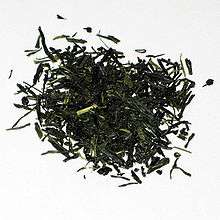Gyokuro
Gyokuro (Japanese: 玉 露, "jade dew") is a type of shaded green tea from Japan. It differs from the standard sencha (a classic unshaded green tea) in being grown under the shade rather than the full sun. Gyokuro is shaded longer than kabuse tea (lit., "covered tea"). While gyokuro is shaded for approximately three to four weeks, kabuse-cha is shaded for approximately one week.[1] The name "gyokuro" translates as "jewel dew" (or "jade dew", referring to the pale green colour of the infusion). While most sencha is from the Yabukita (薮北) cultivar of Camellia sinensis, gyokuro is often made from a specialized variety such as Asahi, Okumidori, Yamakai, and Saemidori.
| Gyokuro | |
|---|---|
 | |
| Type | Green |
| Other names | 玉露, jewel dew / jade dew / pearl dew / precious dew |
| Origin | Japan |
| Quick description | One of the highest grades of Japanese tea. |
Preparation
Gyokuro is normally prepared differently from other green teas.
- Use between 1-2 g per 30 ml (or 1 oz) of water.[2][3]
- Use a temperature range of 50 °C–60 °C (122 °F–140 °F) (instead of 65 °C–75 °C (149 °F–167 °F) for sencha).[2][3] For high-end gyokuro (e.g. National Tea Jury rank), consider a lower temperature, such as 40 °C (104 °F).[4] Then for each additional steeping, increase the temperature by 5.5 °C (10 °F), until the last steeping, which may be increased by up to 11 °C (20 °F).[3]
- Steep between 2-3 minutes, then 30-60 seconds for each additional steep.[2][3]
- The larger quantity of tea and lower-temperature allows for approximately 5-6 steepings.[3]
Notes
Since gyokuro is typically steeped at a lower temperature than most other teas, it is common practice to preheat the teaware to ensure a more steady brewing temperature during steeping time and to prolong the warmth of the lower-temperature tea.[2][3] One standard method is to heat the water at a higher temperature, pour it into and between the various teaware, and finally into the brewing vessel containing the tea leaves. When done properly, by the time the water has transferred between the various teaware and into the brewing vessel it has cooled to appropriate temperature and the teaware has been warmed.[3] One reason for the lower steeping temperature is to preserve the subtle and delicate sweet notes in most gyokuro. One the other hand, it is possible to steep at higher temperatures to bring out more of the vegetable and briny qualities, but usually at risk of homogenizing or removing the sweet notes while increasing bitterness.
Example Steeping
Using a premium Yamecha cv. yabukita gyokuro with 1.1 grams per ounce.
1st Steep: 120 s at 140 °F.
2nd Steep: 30 s at 150 °F.
3rd Steep: 30 s at 160 °F.
4th Steep: 40 s at 170 °F.
5th Steep: 40 s at 180 °F.
6th Steep: 40 s at 195 °F.
Cultivation
Though it is categorized as a type of sencha according to production methods, gyokuro cultivation differs from other sencha teas. Gyokuro tea leaves are shielded from the sun for at least 20 days[2] with straw mats before being harvested. This causes both the amino acid theanine and the alkaloid caffeine in the tea leaves to increase, which yields a sweet flavour.[5] The tea also gains a distinct aroma from the covering process. This type of cultivation is also used in producing tencha, (碾茶) but records indicate this process had already been developed in the Azuchi-Momoyama period.
Market
Gyokuro is one of the most expensive types of sencha available in Japan. The name was originally the product name of the tea made by the Yamamotoyama Tea Company (Japanese). The tea was first discovered by Yamamotoyama's sixth owner, Yamamoto Kahei, in 1835 (Tenpō year 6). The process was completed by another manufacturer at the start of the Meiji period.
The greatest appellation of gyokuro in terms of both quality and quantity is Yamecha, which is produced in Yame in Fukuoka Prefecture. More than 40% of gyokuro is produced in Yame, and in the national tea jury in August 2007, Yamecha held all the ranking positions from first to 26th as the best gyokuro.[4] The Uji district is the oldest gyokuro-producing region in Japan.
Gyokuro should not be confused with "tamaryokucha", a tea produced in the Kyushu region. Tamaryokucha also has a sweet flavour, but its production process differs from that of gyokuro.
See also
- List of Japanese teas
- Theanine, a nootropic extracted from Gyokuro
References
- "How Gyokuro is Processed - IPPODO". www.ippodo-tea.co.jp.
- "Gyokuro". www.myjapanesegreentea.com.
- "Gyokuro - How to Brew Gyokuro Green Tea". www.o-cha.com.
- Result of 2007 National Tea Jury Archived May 15, 2011, at the Wayback Machine (in Japanese)
- "Components of Gyokuro| IPPODO". www.ippodo-tea.co.jp.